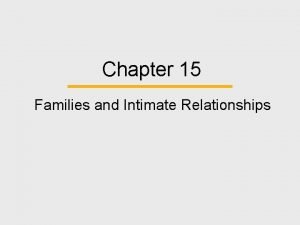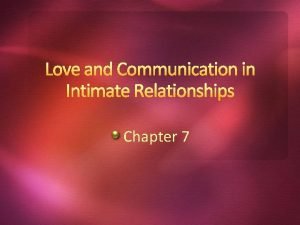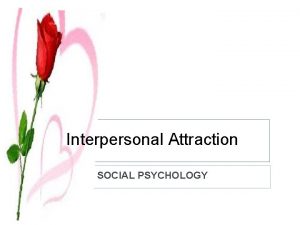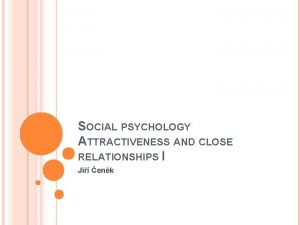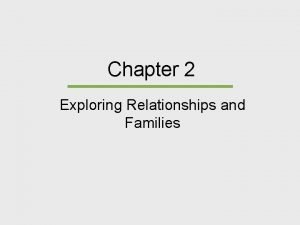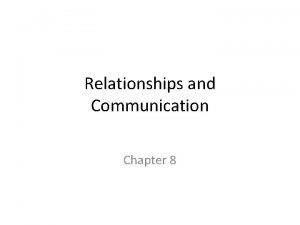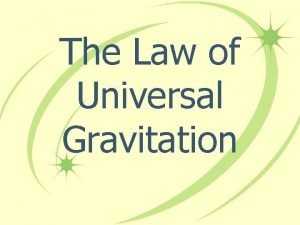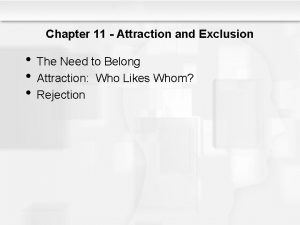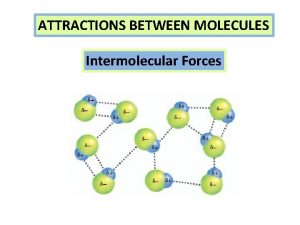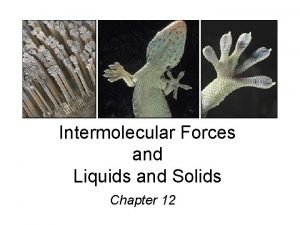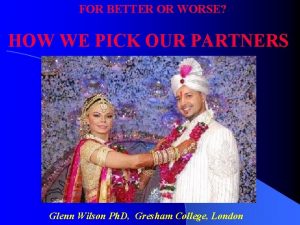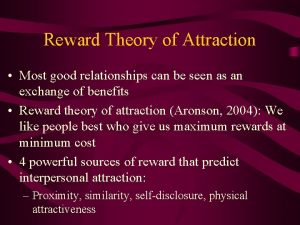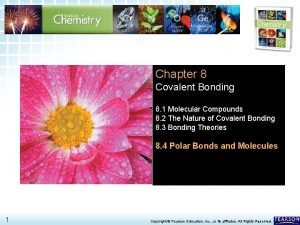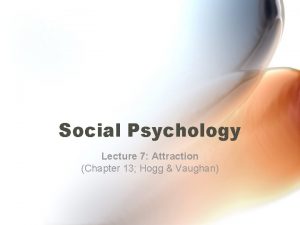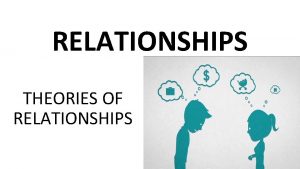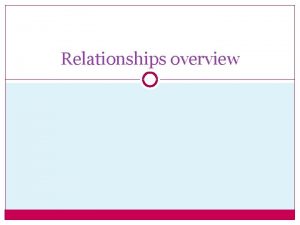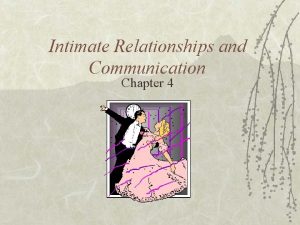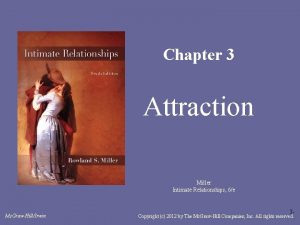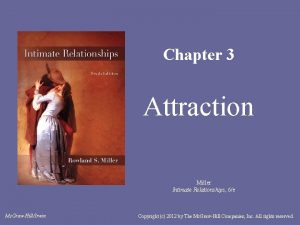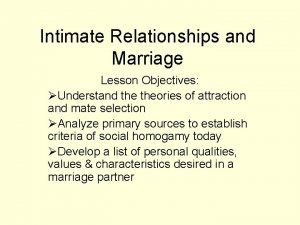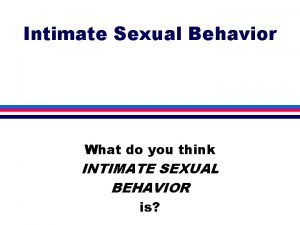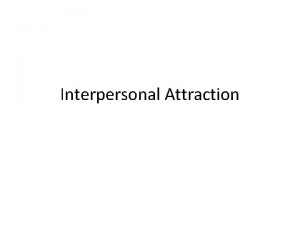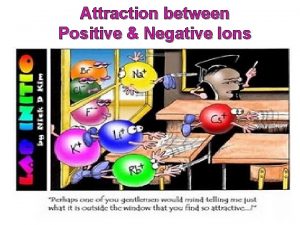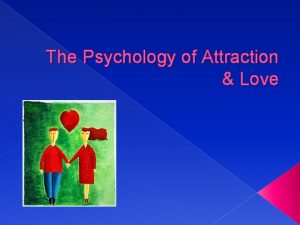Intimate Relationships Theories of Attraction 1 2 3





























- Slides: 29

Intimate Relationships

Theories of Attraction 1. 2. 3. 4. 5. Propinquity (Proximity) Familiarity Physical Similarity Reciprocity

Attraction – A Matter of Rewards ● Fundamental assumption ◦ We are attracted to others whose presence is rewarding to us (Clore & Byrne, 1974) ● Two different types of rewards ◦ Direct – received from interactions with others ◦ Indirect – benefits that are merely associated with someone else

Proximity – Liking Those Near Us ● Generally people become acquainted with , and attracted to , someone who lives, works, shops, and plays nearby ◦ To meet people is not necessarily to love them, but to love them we must first meet them! ● Correlation b/w physical proximity interpersonal attraction ● Think about relationships in the classroom… &

Proximity ● Propinquity appears to lead to attraction in a variety of situations ● This tendency is attributable to: 1. People near to us have more opportunities to REWARD us 2. EXPECTATION of future interaction with those who live and work near us

Proximity – Experiment ● 270 MIT students randomly assigned to apartments within 17 -building campus complex ● After 3 months, asked to name 3 closest friends within the complex

Proximity ● Why does proximity have such influence? ◦ When others are nearby, it’s easy to enjoy whatever rewards they offer ● The expense and effort of interacting with a distant partner make distant relationships more costly overall

Familiarity – Repeated Contact ● Related to propinquity, ◦ The closer we are to someone, the more we see them and the more familiar that person becomes ● The mere exposure effect is an increase in positive feelings toward a novel stimulus (person) based on frequent exposure to it (him/her)

Familiarity – Experiment ● Moreland Beach (1992) had college women attend certain classes either 15 times, 10 times, or 5 times per semester ● They never talked and simply sat there ● At the end of the semester, real students were given pictures of the women and asked for their reactions ● The more familiar the women were, the more attracted to them the students were

Physical Attractiveness ● Proximity brings people together, what gets us to notice each other? ● Three views: ◦ Natural selection ◦ Averages ◦ Bias for beauty, “What is beautiful is good”

Physical Attractiveness ● Natural Selection ● Women prefer men who have the resources to be good providers ◦ Survival of the fittest ◦ What determines who is “fit”? ◦ Competition for limited resources, to survive, reproduce, and raise children ◦ Development of adaptive behaviours ◦ Since women were unable to both care for infants and gather food ● Men preferred women who could ◦ Bear healthy babies, feed their children, and successfully raise them

Physical Attractiveness ● Theory of Averages ◦ Good-looking faces in both sexes have features that are neither too large nor too small �Indeed, they are quite average ◦ However, does not mean that gorgeous people have bland, ordinary looks ◦ A more universal look at what is goodlooking



Averages ● These faces are all proportional to one another… ◦ No nose is too big, no eyes are too small, nothing is exaggerated, or underdeveloped ● Averaged faces are also symmetrical, with the two sides of the face being mirror images of one another ● Thus, beautiful faces seem to combine the best features of individual faces in a balanced, well-proportioned whole

Physical Attractiveness ● “What is beautiful is good” ◦ Physical attractiveness has substantial influence on first impressions ◦ We tend to assume that good-looking people are more likable, better people than those who are unattractive (Brewer & Archer, 2007) ● Newborn infants exhibit preferences for faces like those that adults find attractive too ◦ They spend more time gazing at attractive than unattractive faces

What is beautiful is good – Experiment (Dion, Berscheid, and Walster, 1972) Male and female participants judged that physically attractive people were more likely than the opposite to be more: ◦ Kind, strong, outgoing, nurturing, sensitive, interesting, poised, exciting ● Also, they would have futures that involve: ◦ More prestige, happier marriages, professional success, and more fulfilling lives ●

Phys. Attract. Long-term Impacts ● What about the long run? ◦ Berscheid et al. (1972) Yearbook Study ◦ Obtained ratings of college yearbook photos ◦ Interviewed (then) middle-aged graduates �Beauty = More likely to marry �What about marital satisfaction, life satisfaction, & overall happiness? �No big differences

Similarity – Liking those who are like us ● What kinds of similarity? ◦ Demographics (Social homogamy) �Attraction from similar social and cultural backgrounds �Age, sex, race, education, religion, social class ◦ Personality �Traits (The Big 5) – Openness, conscientiousness, extraversion, agreeableness, neuroticism �Partners with similar personalities have happier marriages than do spouses with different styles (Gaunt, 2006) ◦ Values & attitudes �The more agreement, the more liking �No danger in having “too much in common” �The more similar they are, the more they like each other

Reciprocity – Liking those who like us Just knowing that someone likes us fuels our attraction to that person ● Reciprocal liking sometimes happens because of a self-fulfilling prophecy : ● ◦ When we expect people to like us, we elicit more favourable behaviour from them and show more to them ● Aronson & Worchel (1966) have suggested that reciprocal liking may account for the effect of similarity on attraction

Reciprocity ● The Matching Phenomenon ◦ To enjoy the most success in the relationship marketplace, we should pursue partners who are likely to return our interest ◦ Matching Formula �A Potential Partner’s Desirability = His/Her Physical Attractiveness x Their Probability of Accepting You ◦ Therefore, the most appealing potential partner is someone who is moderately attractive and who seems to offer a good chance of accepting us

Reciprocity ● Our exp. on others’ acceptance have much to do with our mate value (overall attractiveness as a reproductive partner) ◦ People with high mv’s are highly sought by others and can reasonably expect most people to be interested in them ● Thus, similarity in physical attractiveness may operate as a screening device

What is Love? ● Placemat ◦ Individually come up with a definition ◦ In groups, share your definition with one another ◦ As a whole, come up with a complete definition

Three components in Love ● In simple terms, the strong positive emotion of regard and affection ● 3 Components ◦ Intimacy �Close, connected, bonded feelings between two people ◦ Passion �The drives that lead to romance, physical attraction, sexual consummation in a relationship ◦ Commitment �The decision that one loves someone (short-term) and commitment to maintain that love (long-term)

Sternberg’s Seven Types of Love

Love over Time

NOT for Homework Due to Dance!!! ● Connecting Theory to Music 1. Choose any song about love and/or relationships 2. Identify the parts of the lyrics that indicate the components of love 3. Determine which of the 7 Types of Love this song is talking about 4. Write a short paragraph (4 -5 sentences) explaining your analysis (Explain how the lyrics represents one of the components of love) 5. Include the lyrics in your homework

Connecting Theory to Music I’ll Stand By You by The Pretenders Intimacy Oh, why you look so sad? Tears are in your eyes Come on and come to me now Don't be ashamed to cry. Let me see you through 'cause I've seen the dark side too When the night falls on you, you don't know what to do Nothing you confess, could make me love you less I'll stand by you, I'll stand by you Won't let nobody hurt you, I'll stand by you Intimacy So if you're mad, get mad Don't hold it all inside, come on and talk to me now Commitment Hey, what you got to hide? I get angry too, well I'm a lot like you When you're standing at the crossroads And don't know which path to choose Let me come along, 'cause even if you're wrong I'll stand by you, I'll stand by you Won't let nobody hurt you, I'll stand by you

Explanation In The Pretender’s song, “I’ll Stand By You”, the band sings, “Oh, why you look so sad? Tears are in your eyes, come on and come to me now. ” This shows intimacy as it describes close bonded feelings between them and a desire to be close to each other. When they repeat, “I’ll stand by you” , it shows evidence of commitment , which can indicate either short or long-term. Finally, they sing, “So if you're mad, get mad. Don't hold it all inside, come on and talk to me now”, which also indicates intimacy through the desire to share feelings with one another. Therefore, as this song shows indication of both intimacy and commitment, according to the Triangular Theory of Love , the band is singing about Companionate Love.
 Family life today
Family life today Intimate family chapter 7
Intimate family chapter 7 Define the relationship chap 7
Define the relationship chap 7 Intimacy after incarceration
Intimacy after incarceration Attraction and proximity
Attraction and proximity Interpersonal attraction definition
Interpersonal attraction definition Attraction and close relationships in social psychology
Attraction and close relationships in social psychology Periwinkle doerfler
Periwinkle doerfler Intimate family chapter 2
Intimate family chapter 2 Intimate antonym
Intimate antonym Intimate family chapter 6
Intimate family chapter 6 Intimate language register
Intimate language register 01 me line intimate
01 me line intimate Intimate family chapter 6
Intimate family chapter 6 Dewgarden foaming intimate wash benefits
Dewgarden foaming intimate wash benefits Abcde of intimate relationship
Abcde of intimate relationship Meaning of initmacy
Meaning of initmacy Intimate zone in communication
Intimate zone in communication Zones of space communication
Zones of space communication Intimate distance is
Intimate distance is The law of universal attraction
The law of universal attraction Katherine mansfield the dolls house
Katherine mansfield the dolls house Reciprocity of attraction
Reciprocity of attraction Intermolecular forces and boiling point
Intermolecular forces and boiling point Intermolecular attraction
Intermolecular attraction Genetic sexual attraction
Genetic sexual attraction What is gender transformative approach
What is gender transformative approach Example of reward theory of attraction
Example of reward theory of attraction Polar attraction chapter 8
Polar attraction chapter 8 Reciprocity of attraction
Reciprocity of attraction
